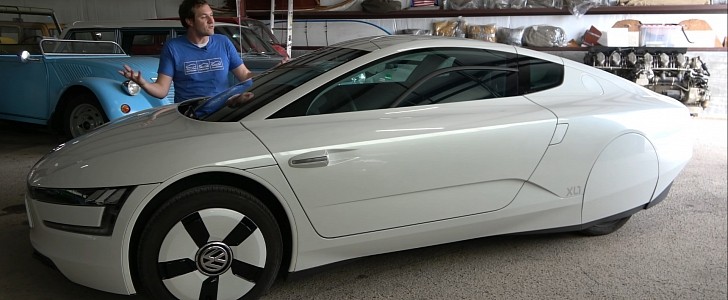Presented in 2011 as a concept, the final iteration of the Volkswagen 1-liter car entered production in 2013 in limited numbers. Originally priced at €111,000 or approximately $130,830 at current exchange rates, the XL1 is insanely economical and it boggles the mind in terms of quirks.
The Lane Motor Museum in Nashville borrowed an XL1 to Doug DeMuro for reviewing, and the first noteworthy observation comes in the guise of looks. Not exactly beautiful, this engineering masterpiece features aero-focused covers for the front wheels, fared-in rear wheels, a canopy-inspired cabin, and butterfly doors that give the impression of a proper supercar.
Moving on to the interior, the seats and footwells are offset. Doug also touches on the low-resolution displays on the doors, which are connected to a couple of video cameras. There’s no rearview mirror per se, and Volkswagen couldn’t make a case for a glovebox either. Many of these decisions are related to the car’s main purpose, specifically fuel efficiency.
Under the New European Driving Cycle, the XL1 was originally rated at 0.9 liters per 100 kilometers or 261 miles to the gallon. Proved to 0.8 liters (294 miles per gallon) in extreme hypermiling conditions, the XL1 features a lot of carbon fiber and a magnesium-alloy subframe. These weight-saving materials translate to a curb weight of just 795 kilograms (1,753 pounds) even though you’re looking at a series hybrid à la the e-Power from Nissan.
Mounted right behind the seats, an 800-cc turbo diesel with two cylinders and 48 PS (47 horsepower) is connected to a dual-clutch transmission. The plug-in hybrid electric motor is located between the oil-burning engine and DSG transmission, and at the very most, it enables a zero-emissions driving range of 50 kilometers (31 miles) in conjunction with a 5.5-kWh battery.
Discontinued in the aftermath of the Dieselgate scandal, the XL1 isn’t likely to get a replacement due to Volkswagen’s 180-degree turn toward BEVs and the European Union’s increasing dislike of internal combustion mills.
Moving on to the interior, the seats and footwells are offset. Doug also touches on the low-resolution displays on the doors, which are connected to a couple of video cameras. There’s no rearview mirror per se, and Volkswagen couldn’t make a case for a glovebox either. Many of these decisions are related to the car’s main purpose, specifically fuel efficiency.
Under the New European Driving Cycle, the XL1 was originally rated at 0.9 liters per 100 kilometers or 261 miles to the gallon. Proved to 0.8 liters (294 miles per gallon) in extreme hypermiling conditions, the XL1 features a lot of carbon fiber and a magnesium-alloy subframe. These weight-saving materials translate to a curb weight of just 795 kilograms (1,753 pounds) even though you’re looking at a series hybrid à la the e-Power from Nissan.
Mounted right behind the seats, an 800-cc turbo diesel with two cylinders and 48 PS (47 horsepower) is connected to a dual-clutch transmission. The plug-in hybrid electric motor is located between the oil-burning engine and DSG transmission, and at the very most, it enables a zero-emissions driving range of 50 kilometers (31 miles) in conjunction with a 5.5-kWh battery.
Discontinued in the aftermath of the Dieselgate scandal, the XL1 isn’t likely to get a replacement due to Volkswagen’s 180-degree turn toward BEVs and the European Union’s increasing dislike of internal combustion mills.











